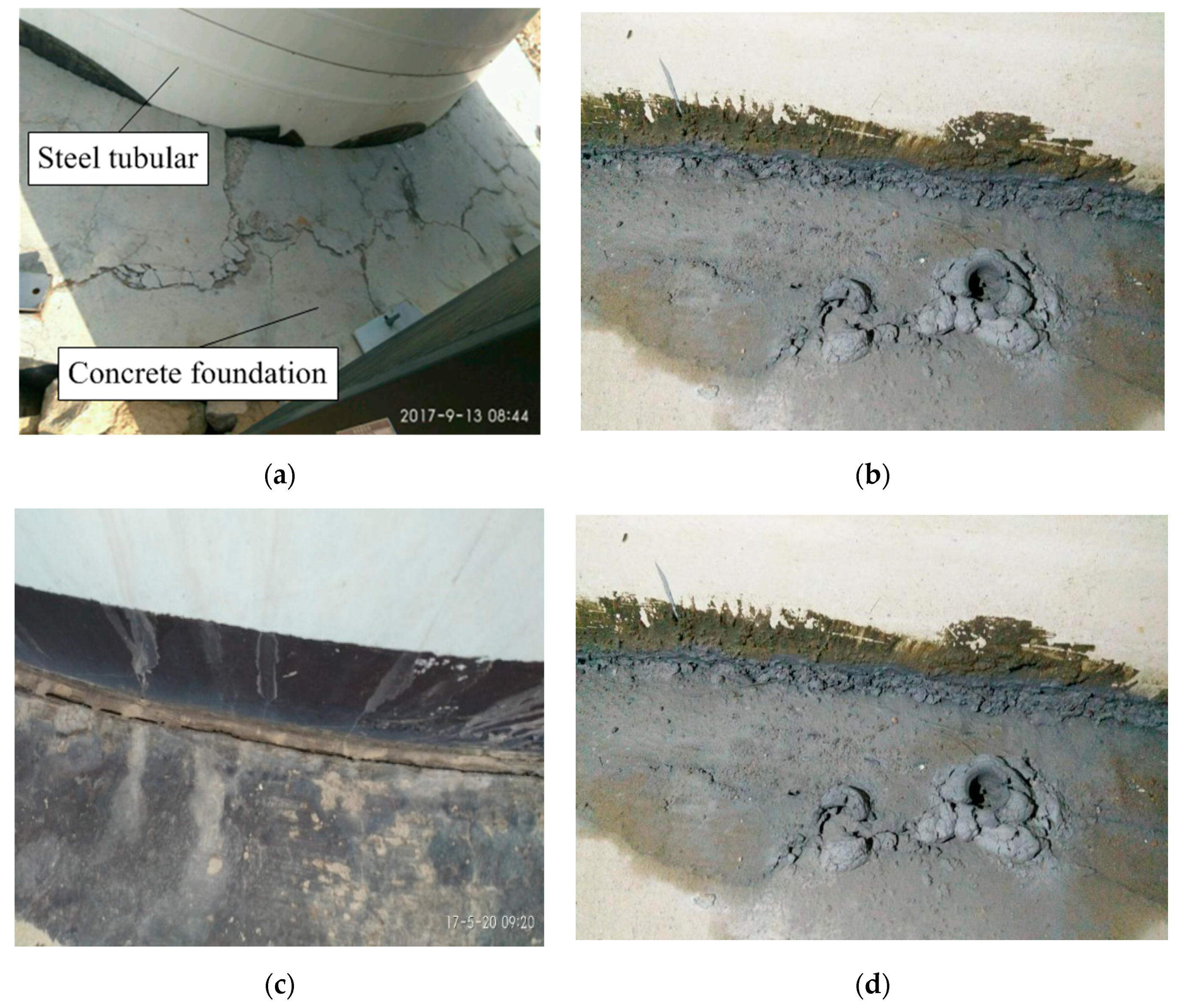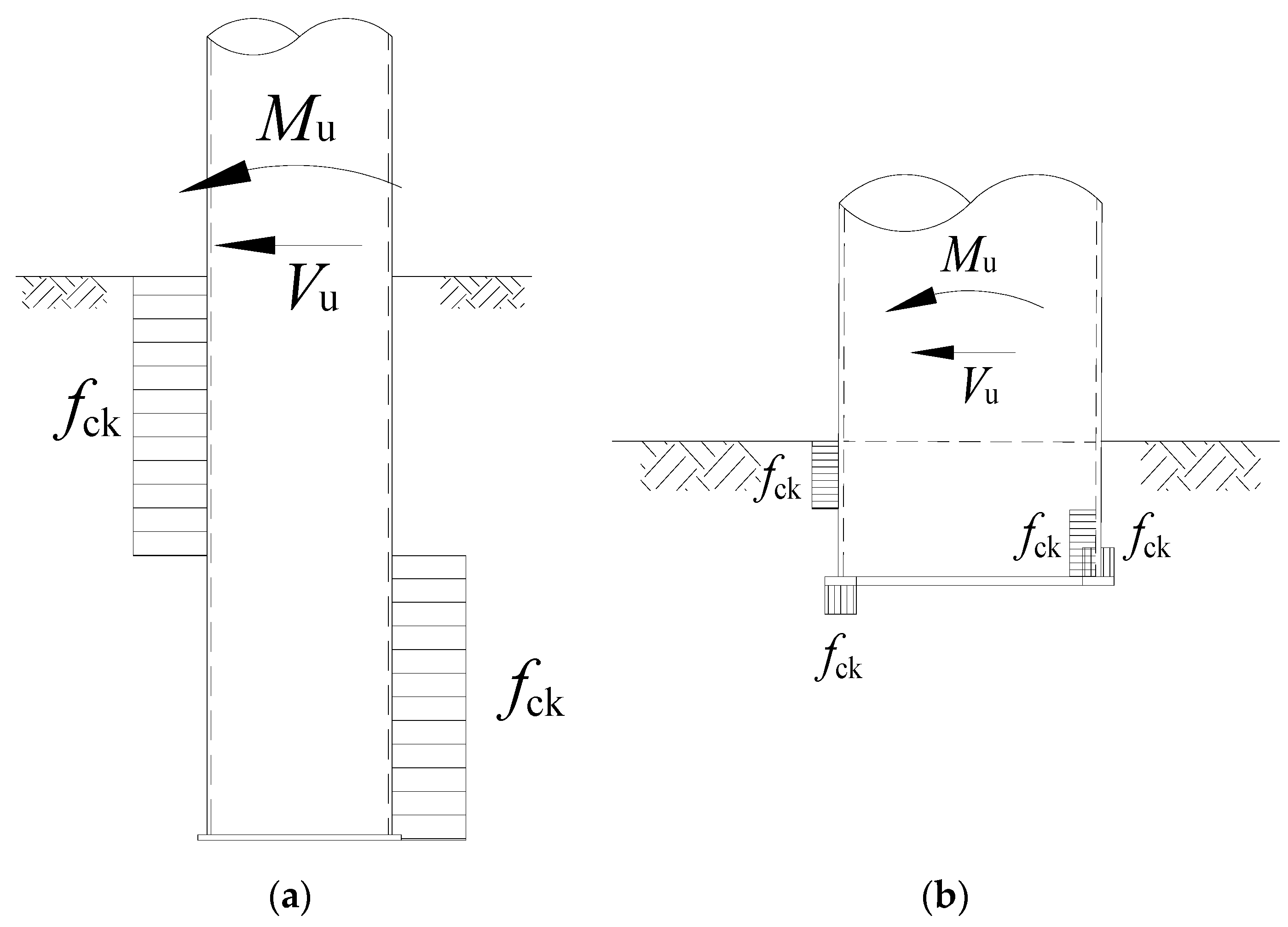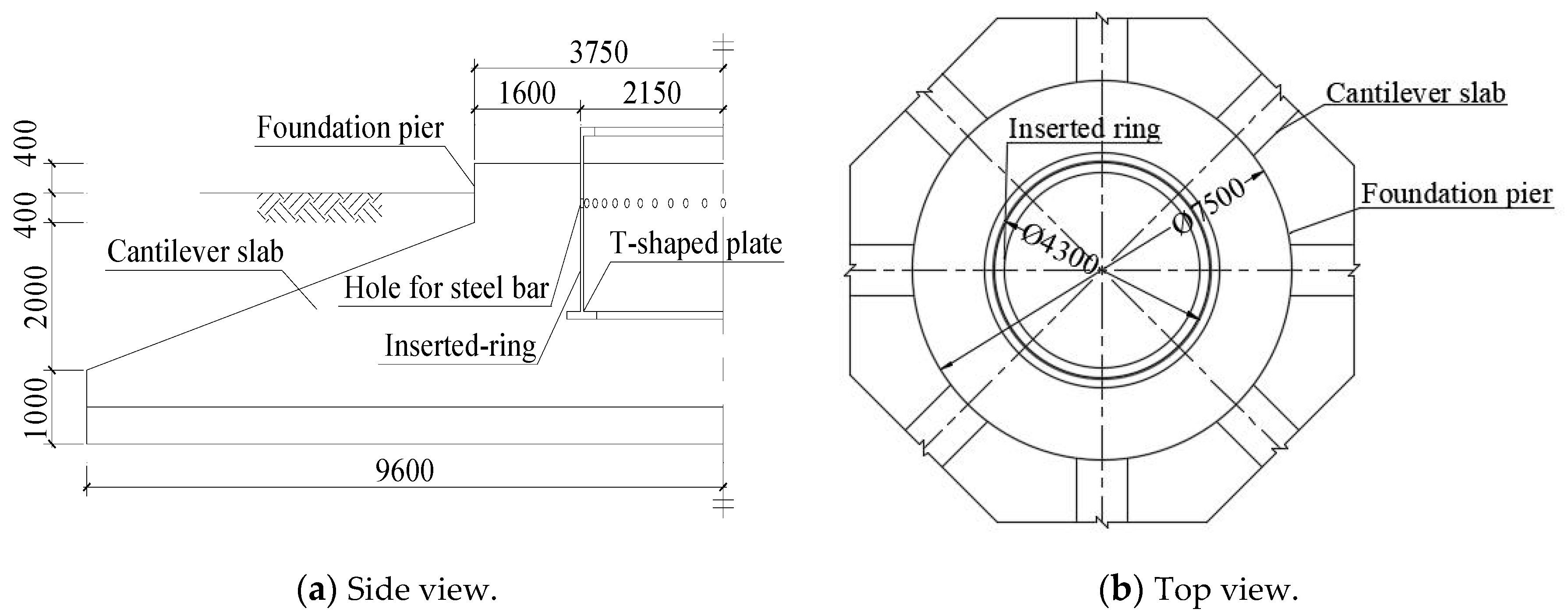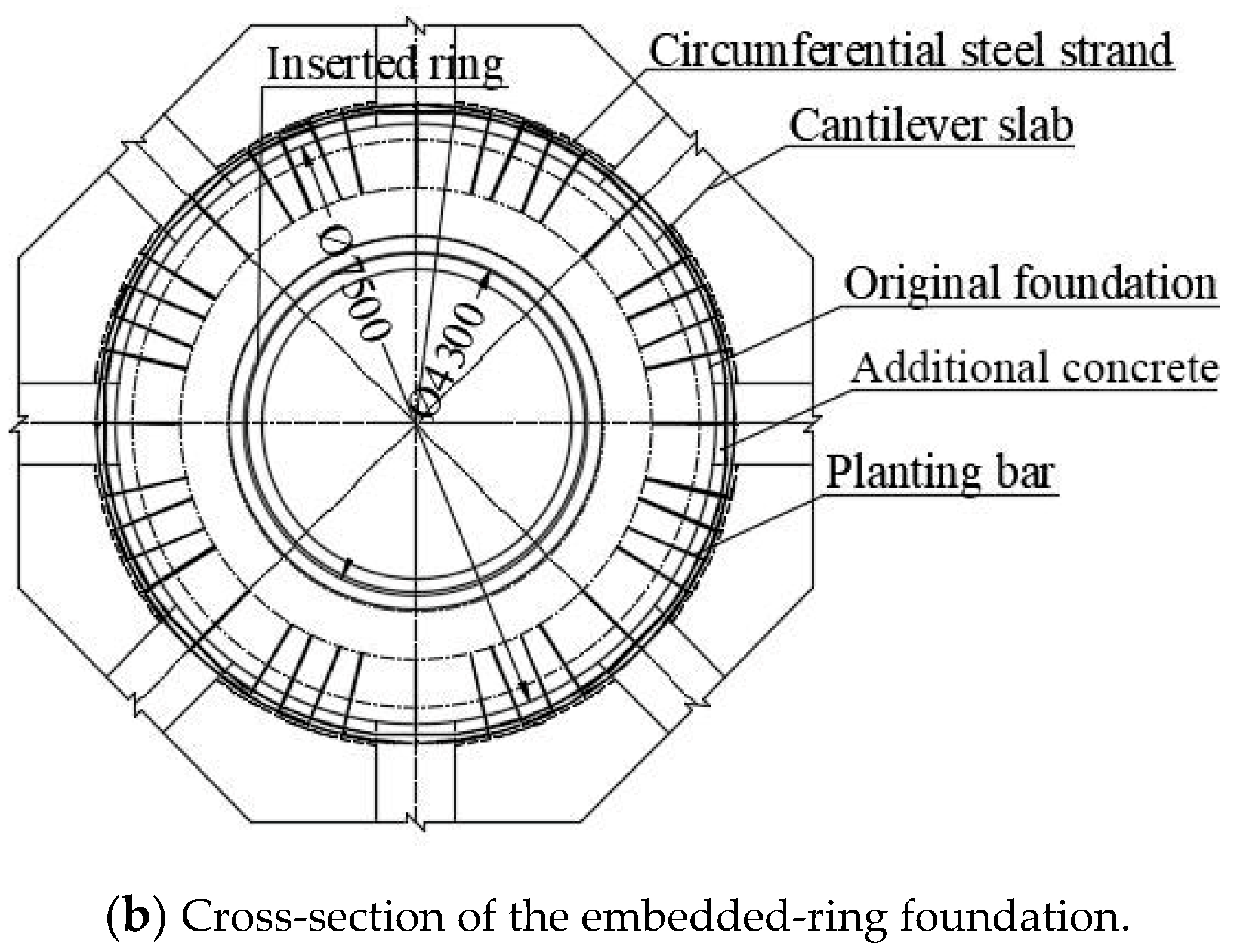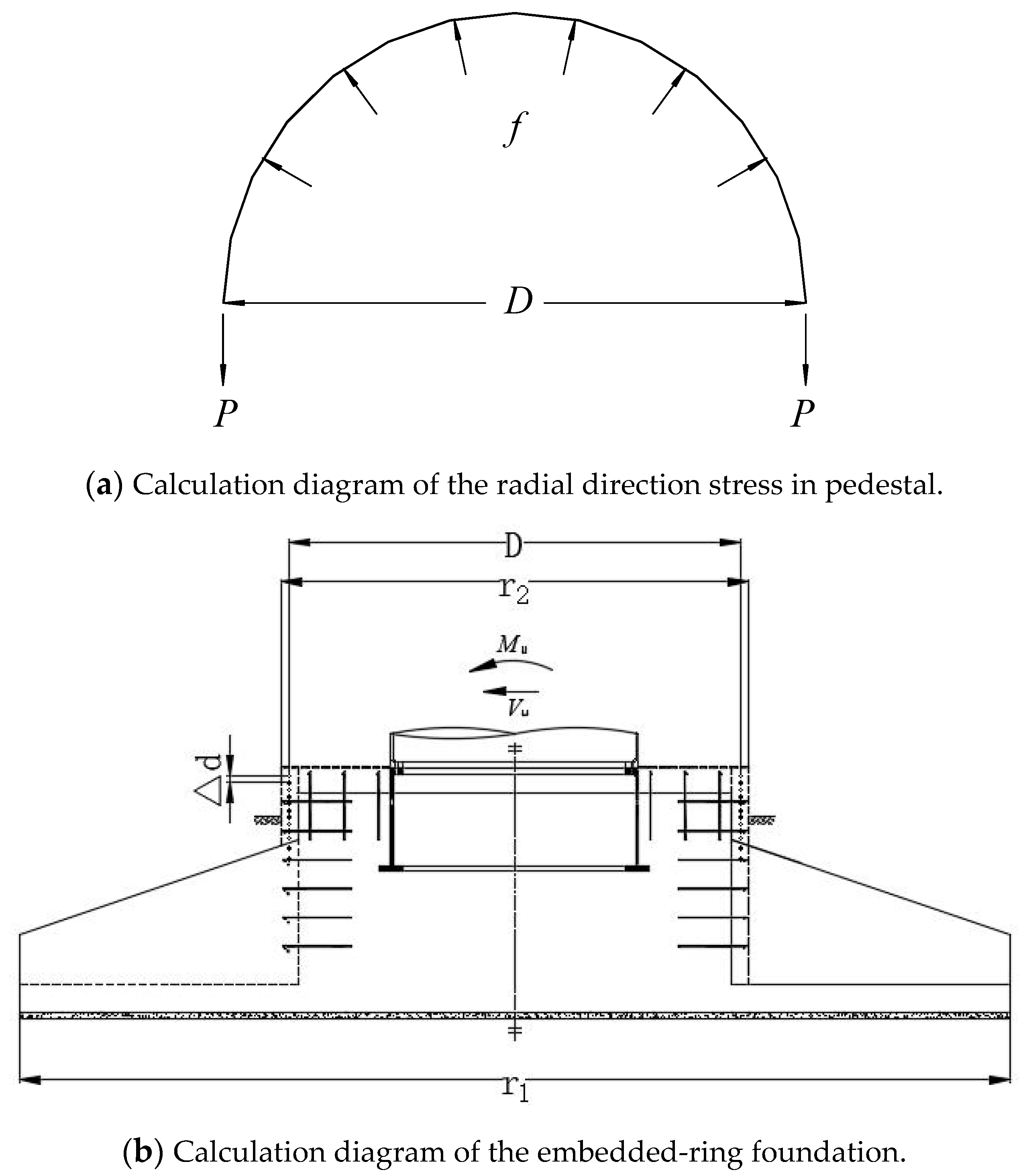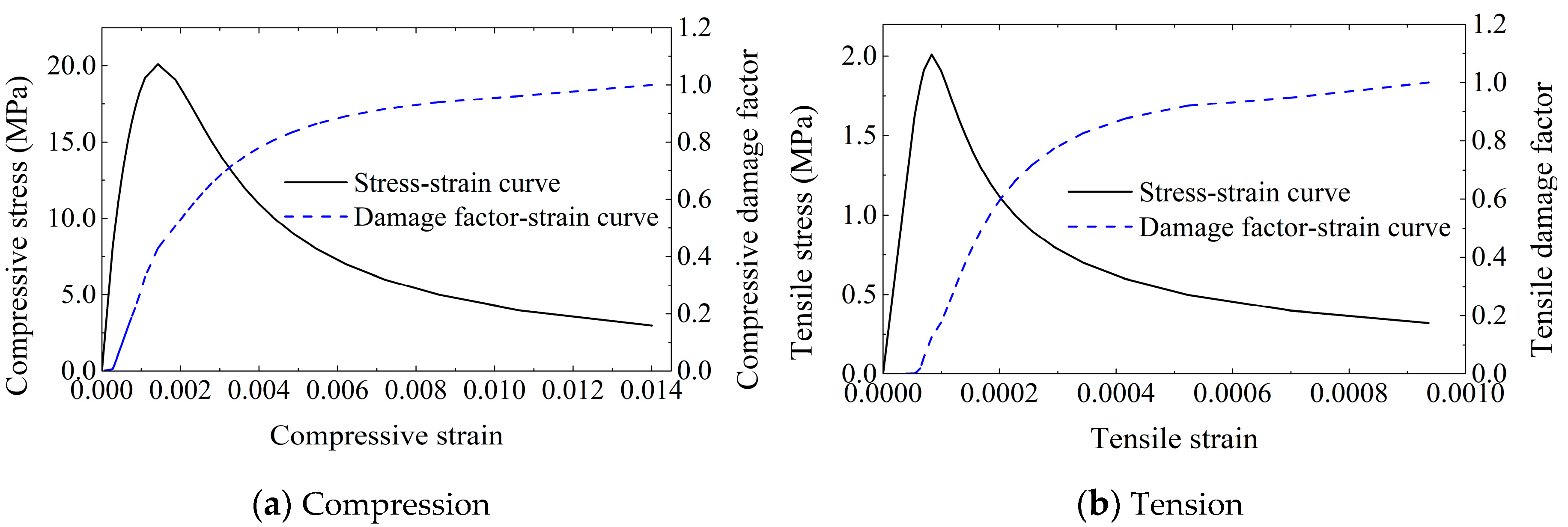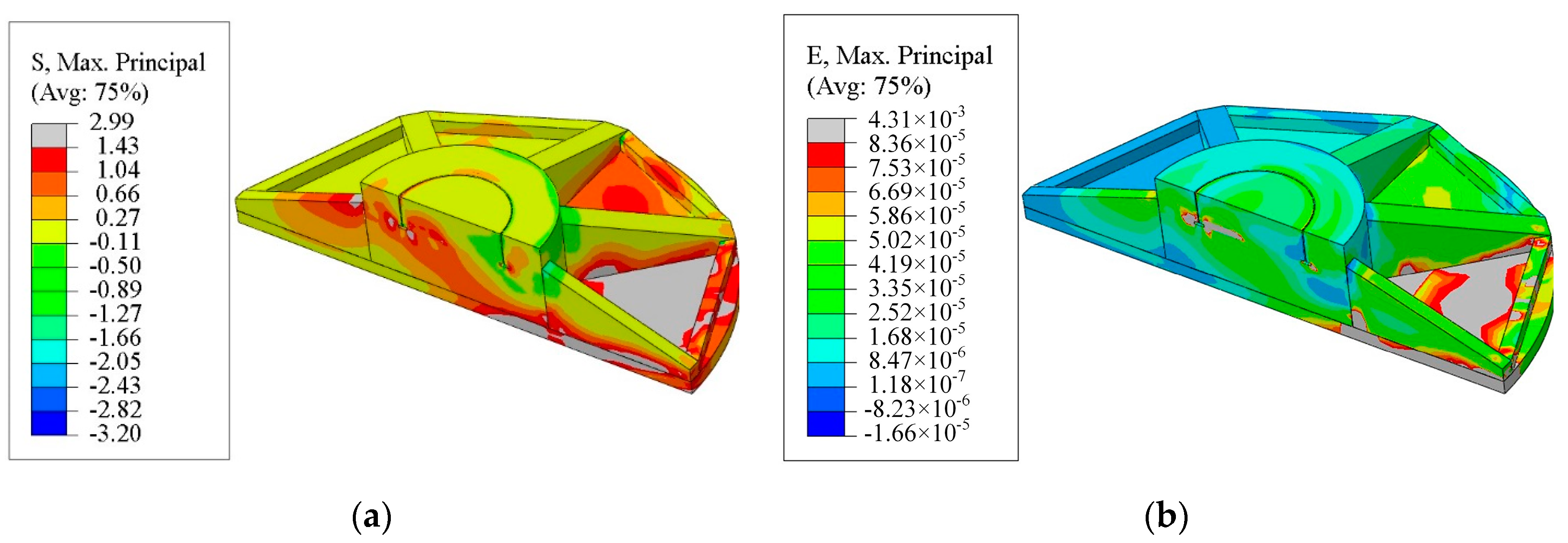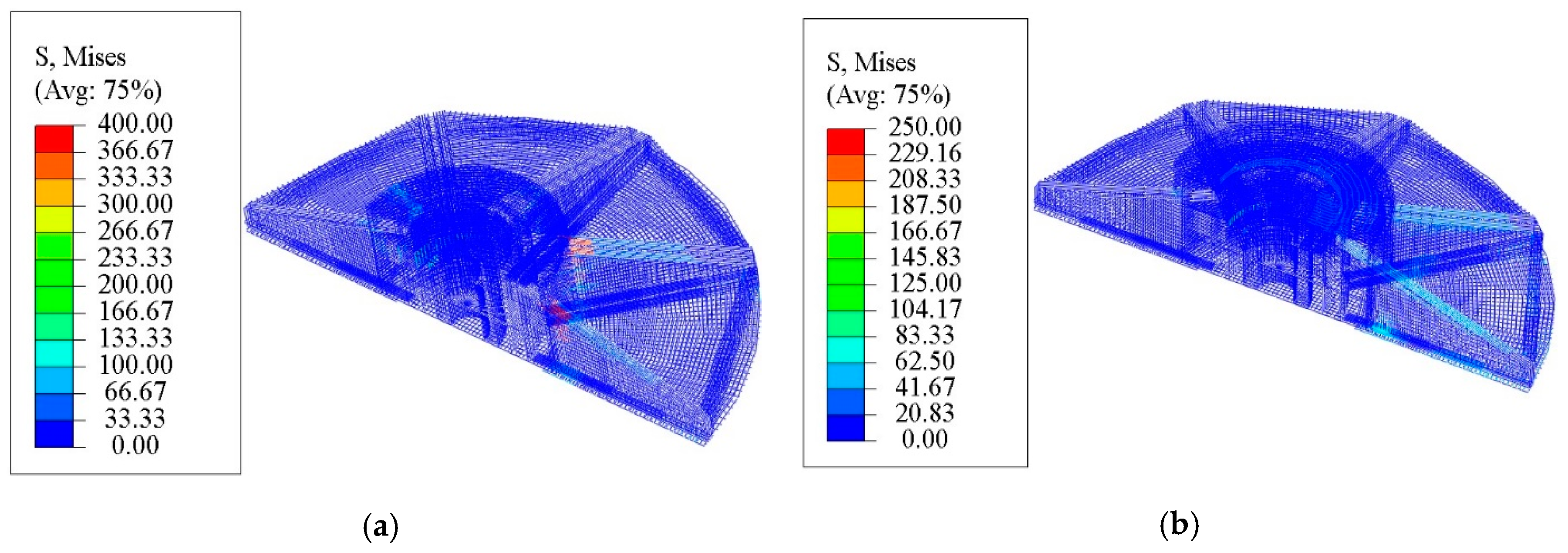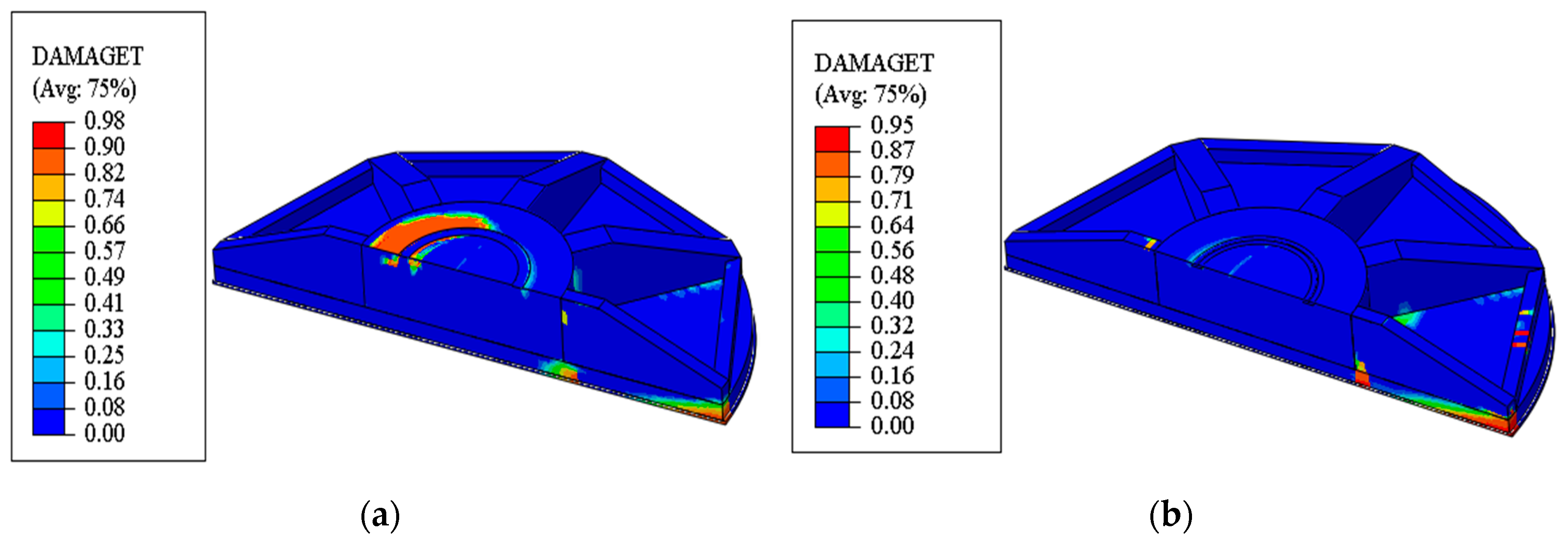1. Introduction
Due to climate change and the desire to preserve fossil energy resources, wind energy has received worldwide interest and wind power has become one of the fastest-growing sources of energy in the world. Wind turbines are playing a significant role in the infrastructure development of many countries and regions. The global cumulative installed wind capacity reached 539.1 GW by the end of 2017. In China, onshore wind turbines have been rapidly increasing over the past ten years as the Chinese government attempts to meet its renewable energy targets. In earlier years, the steel towers of wind turbine systems were usually connected by embedding steel rings into concrete foundation piers. However, embedded depths are usually too shallow to provide sufficient constraint stiffness for steel towers. Under the high-cycle fatigue loading induced by a wind turbine’s normal operation, higher fatigue stress occurs on the steel tower, the concrete foundation, and other structural components [
1]. Therefore, different damage types have recently occurred in a large number of existing onshore concrete foundations with embedded steel rings as the connection method with the steel towers, such as surface cracks (
Figure 1a), concrete leaching (
Figure 1b), gaps between the steel ring and the foundation pier (
Figure 1c), and cracking above the T-shaped plate of the insert ring (
Figure 1d). Excluding thermal and drying shrinkage cracking during the production process or in the foundation’s early age, the damage causes of embedded-ring wind turbine foundations may have different origins such as fatigue loading, low strength concrete, unreasonable structural design, poor workmanship, structural defects, and so on [
2]. The occurrence and development of damage signs in embedded-ring wind turbine foundations are often a slow process over years or even months. The interface concrete around the steel ring is constantly ground up under the dynamic loading of the wind turbine system because of the insert ring’s structural defects. Rainwater penetrates into the gaps and leads to tiny grains of concrete leaching, as shown in
Figure 1b. At present, the damages in embedded-ring foundations have entered a centralized period of considerable increase in China. In some extreme cases, the gaps between embedded-ring and concrete foundations have exceeded more than 20 mm that will lead to the catastrophic collapse of turbines if the gaps and cracks cannot be handled in a timely and reasonable manner. The field investigations in some wind farms show that embedded-ring foundation damages are an urgent and widespread issue which must be taken seriously.
In recent years, some researchers have paid more attention to the common quality defects of embedded-ring foundations for wind turbine systems. Currie et al. [
3] presented an assessment of embedded-ring foundation failure modes in large onshore wind turbines and proposed a novel condition-based monitoring solution to aid in the early warning of failure. Fan et al. [
4] proposed a simplified fatigue analysis approach to assess the fatigue strength of the steel ring in an embedded-ring foundation according to the Chinese Classification Society specification. Kang et al. [
1] analyzed the stress distribution in the foundation concrete near the steel ring and found that the gap between the steel ring and the concrete foundation increased the distinct stress, while the stress level increased with the increasing gap. Currie et al. [
5] developed a wireless structural integrity monitoring technique to monitor the stability of wind turbines by measuring the displacement pattern and subsequently alerting authorities of any significant movement of the embedded ring. Huang [
6] proposed a nondestructive testing technique to detect the concrete quality of the interface between the embedded ring and the foundation pier using an ultrasonic method combined with engineering practice. Bai et al. [
7] presented a numerical study on the fatigue behavior of the embedded-ring foundation of onshore wind turbines. Liu and Yang [
8] investigated the interaction of the steel ring and the concrete foundation by numerical simulation and found that the studs welded onto the steel ring can increase the contact between the steel ring and the foundation concrete. Lyu et al. [
9] found that the strength of steel bars threaded through the holes on the wall of the steel ring could not satisfy the shear strength of the foundation and that strengthening measures should be taken in design. Fatigue failure is also a significant failure mode for offshore wind turbines. Braithwaite and Mehmanparast [
10] examined the effect of the connecting bolts’ tightening sequence on preload level maintenance by three different analyses.
The retrofitting measure most commonly used in embedded-ring foundations is to drill holes on the top surface of foundation piers and pump cement slurry to fill gaps and cracks. This method can have an immediate strengthening effect, but the gaps and cracks will occur again in a short time because the force transmission mechanism between the steel embedded-ring and the concrete foundation pier is not changed. Kang et al. [
1] proposed to add annular beams on the top surface of the original foundation pier to improve the compressive stress distribution between the steel embedded ring and the concrete foundation after the cracks and gaps were repaired by pumping cement slurry. The numerical results showed that this strengthening measure can effectively increase the surface strength of the foundation pier but limitedly decrease the local stress of concrete near the T-shaped plate. He et al. [
11] developed a retrofitting strategy for the deficient foundation using an external prestressing technique, in which six girders were installed on the top surface of the foundation pier and prestressed anchor bolts were arranged symmetrically on both sides of the girders. The numerical results showed that the implementation of prestressing loads can reduce the width of cracks near the T-shaped plate. However, this strengthening method requires the drilling of many holes on the top surface of the concrete foundation pier, and reinforcing bars in the concrete must be cut out during the drilling process. In this study, a strengthening method by applying circumferential prestress around the original foundation pier is proposed to improve the stress state of concrete around the insert ring without destroying the original foundation. A series of numerical analyses were carried out to investigate the stress state change in the foundation concrete around the insert ring. The changes in fatigue stress amplitudes before and after strengthening were compared to show the change in fatigue life of the foundation concrete.
2. Design Concept of the Circumferential Prestressed Strengthening Method
Embedded column footing is widely used in steel frame structures because of its advantages of constructive convenience and high bending stiffness, in which the overturning moment acting on the steel frame column base is mainly resisted through the lateral pressure provided by the concrete foundation contacting with the lateral sides of the steel frame column. The axial force acting on the steel column base is transferred to the foundation concrete by contacting with the base plate below. In order to ensure the transfer mechanism, as shown in
Figure 2a, the depth of the tubular steel column embedded in the concrete foundation or column should not be less than 3 times its outer diameter [
12]. Sufficient shear studs should be welded onto the surface of the embedded steel column to obtain an excellent binding force.
The embedded-ring wind turbine foundation, in which the steel ring connected to the bottom flange of the steel tower is embedded into the concrete foundation pier, is similar to an embedded frame column footing in appearance and structural form. However, because the relative depth of the steel ring embedded in the concrete foundation is much less than that of the steel column embedded in the concrete foundation or column, the transfer mechanisms of the ultimate bending capacity are very different between these two forms of embedded foundations. The diameter of the tubular tower base for megawatt wind turbines is generally greater than 4 m and the embedded depth of the steel ring in the wind turbine foundation is usually between 1.2 m and 2 m. Therefore, the ratio of the embedded depth to the diameter of the steel ring is lower than 0.5, which is much smaller than the requirements in JGJ99-2015 [
12]. Reinforcing bars are usually threaded through the holes on the steel ring’s wall to further strengthen the connection between the steel ring and the concrete foundation. In general, no studs are welded onto the steel ring’s wall because most wind turbine companies consider that it has a negative effect on the steel ring’s fatigue strength. Therefore, the overturning moment acting on the tower base is resisted by the anchoring effect of the T-shaped plate and the lateral pressure provided by the foundation concrete contacting with the steel ring, as shown in
Figure 2b.
Figure 3 shows the reinforced concrete beam-slab foundation of a wind turbine, in which the steel tower is connected to the foundation by means of an embedded steel ring. Obvious gaps and cracks occurred on the top surface of the foundation pier and the steel tower swayed noticeably after the wind turbine operated for only 20 months. During the field investigation, it was found that rainwater had permeated into the gaps and cracks between the concrete foundation and the steel ring. The flow of water around the steel ring and through the holes on its wall was induced due to the pumping effect caused by the dynamic loading and then led to the leaching of the concrete and the mortar in the transition zones between the steel ring and the concrete foundation. It was also found that there were no studs welded onto the steel ring’s wall which was connected to the concrete foundation pier only through the reinforcing bars threading through the holes. The local pressure stress of the concrete on and beneath the T-shaped plate as well as on the top edge of the steel ring was relatively large. Under alternating loads, the concrete located at the interface between the steel ring and the concrete foundation pier was ground up, resulting in gradually increasing gaps between them. After drilling holes from the top surface of the foundation pier to the area above the T-shaped plate, cracks were observed on the lateral walls of the holes using an endoscope, as shown in
Figure 1d.
The fatigue life of concrete mainly depends on the stress level and the stress amplitude of concrete under the action of fatigue loading [
13], and then it can be improved by decreasing their values. Prestressing is a mature technique of introducing a predetermined stress into the reinforced concrete structure to improve its behavior. The cracking of the concrete structure can be reduced or avoided by pre-compression, providing the ability to resist the crack-inducing tensile stresses generated by in-service loading, and then the fatigue life can be enhanced because the cyclic stress amplitude is reduced [
14]. In this paper, a circumferential prestressing technique is proposed to exert on the pier of the beam-slab spread foundation. Beforehand, the gaps and cracks on the foundation pier should be filled and repaired using high strength epoxy resin with better elasticity than concrete. In order to reduce the pressure stress of the concrete on and beneath the T-shaped plate, the overturning moment resisted by the lateral pressure of the foundation pier contacting with the steel ring should be increased by increasing the embedded depth of the steel ring. Because the bolts of the bottom flange may become loose during the wind turbine’s operation, regular inspections should be carried out over the whole service life. Therefore, the concrete foundation pier is proposed to be heightened to the bottom flange of the steel tower by planting reinforcing bars as far as possible, thereby increasing the embedded depth of the steel ring in the wind turbine foundation. Finally, the circumferential prestressed steel strands are arranged on the lateral surface of the column pier to remove or reduce the tensile stress generated by external loads, as shown in
Figure 4.
For a circular cross-section as shown in
Figure 5, the radial compressive stress
f generated in concrete by applying circumferential prestress can be obtained from Equation (1) according to the equilibrium condition:
where Δ
d is the spacing between steel strands,
p is the value of pretension force, and
D is the diameter of the circular cross-section. The edge stress in the tension zone of the foundation pier can be determined according to Equation (2) for meeting the first-level cracking control requirements in the Code for Design of Concrete Structures (GB50010-2010) [
15]:
where
is the maximum principle stress at the edge of the concrete foundation pier under the characteristic value of load combination and
is the edge prepressing stress of the concrete foundation pier.
The characteristic value
P1,k of gravity stress at the midpoint of the cantilever foundation slab on the windward side can be calculated according to Equation (3):
where
Gk is the characteristic value of self-weight including foundation and soil,
Pk,max is the characteristic value of the maximum base reaction,
A is the area of the foundation slab;
r1 and
r2 are the radius of the circular foundation slab and the foundation pier, respectively, and
ac is the width of the compression zone of the foundation slab [
16].
The characteristic value of the windward-side moment in the radial direction of the foundation slab at the root of the foundation pier can be calculated by Equation (4) [
17]:
The standard value of the maximum tensile stress at the edge of equivalent section is as follows:
where
I is the moment of inertia of the section and
ymax is the distance between the neutral axis and the edge of the tension zone under bending condition.
To ensure the foundation pier under the three-dimensional pressure state, the edge prepressing stress of the concrete foundation pier
is taken to be
, in which the losses of prestressing stress due to short-term relaxation, anchorage slip, elastic deformation of concrete, friction, etc., are all included. The initial prestressing force
p of each strand applied to the foundation pier immediately after tensioning and anchoring should be calculated by Equation (6):
4. Fatigue Strength Calculation
Wind-induced fatigue is a random variable amplitude fatigue problem under the variable loading of a wind turbine system [
13]. The variable amplitude load spectrum is a relatively precise method for analyzing the fatigue resistance of structural components [
4]. Generally, variable amplitude loads can be obtained through two methods. One is to obtain the load spectrum with the help of existing similar structures or numerical models under various load cases; the other is to estimate the variable amplitude load spectrum according to damage theories and engineering experiences. However, the variable amplitude load spectrum is difficult to apply in practical engineering design because of its high time cost. The fatigue resistant design based on the constant amplitude load equivalently generated by the variable amplitude load spectrum is a simple, rapid, and comparatively accurate method [
20,
21,
22]. In this paper, the fatigue analyses and verification of the embedded-ring foundation were carried out according to the equivalent fatigue damage load method.
According to the Design regulations on subgrade and foundation for wind turbine generator system (FD003-2007) [
23], the fatigue strength calculation of materials for wind turbine foundation should meet the requirements of the Code for Design of Concrete Structures (GB 50010) [
15]. In GB50010, the fatigue strength of steel bar and concrete are determined according to the largest acting amplitude corresponding to 2 × 10
6 circles under randomly variable actions such as wind, waves, traffic, etc. However, the required design life of a wind turbine system is generally 20 years, during which time the number of operational load cycles to failure should be 1 × 10
7 times. The accepted design code of wind turbine systems by manufacturers is the Guideline for the Certification of Wind Turbines compiled by Germanischer Lloyd WindEnergie GmbH [
24], in which CEB-FIP (fib Model Code for Concrete Structures 2010) [
25] is suggested to be applied for the fatigue verification of concrete.
The calculation of fatigue life of a concrete structure within the design life has been given by the CEB-FIB Model Code [
25], where the fatigue life of concrete under equivalent fatigue load can be calculated according to the concrete stress level. This method can be used to check the fatigue strength of concrete under different equivalent cycle times. The fatigue life of the concrete outside the embedded-ring and above the T-shaped plate can be calculated by Equation (7):
where
is the coefficient which depends on the age of the concrete
t in days when fatigue loading starts;
is a coefficient which takes into account the effect of high mean stresses during loading, and for fatigue loading it may be taken as 0.8; and
is the standard value of concrete compressive strength.
The compressive stress level and the stress level range of concrete can be calculated by Equations (8)–(10):
where
is the minimum compressive stress of concrete,
is the maximum compressive stress of concrete,
is the maximum compressive stress level,
is the minimum compressive stress level, and
is the stress level range.
The number
N of cycles causing fatigue failure of concrete may be estimated from Equations (11)–(14):
The fatigue requirements under cyclic loading will be met if the required lifetime (number of cycles) is less than or equal to the number of cycles to failure:
The compressive stress and the fatigue strength of concrete above the windward-side T-shaped plate before and after strengthening are shown in
Table 6, from which it can be seen that the compressive stress of concrete above the windward-side T-shaped plate was significantly increased under the valley value of fatigue loading and decreased under the peak value of fatigue loading. Therefore, the fatigue stress amplitude was reduced and the fatigue life of concrete above the windward-side T-shaped plate could be improved.
